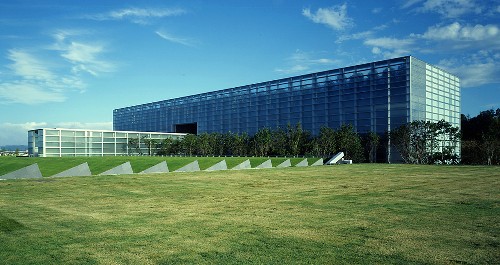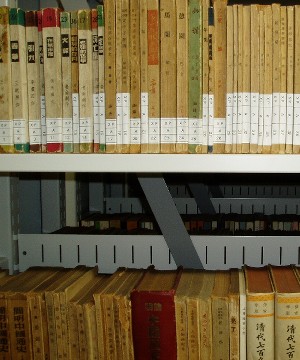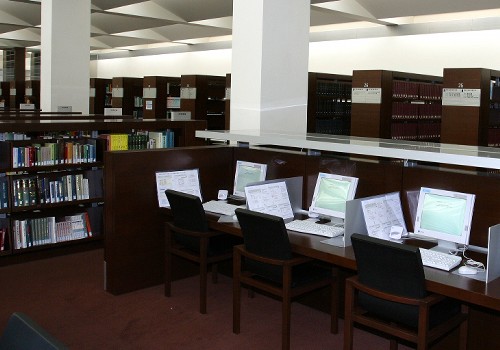| 04/09/02 | ||||||||||||||||||||||||||||||||||||||||||||||||||||||||||||||||||||||
| The Asian Resources Room of the Kansai-kan of the National Diet Library | ||||||||||||||||||||||||||||||||||||||||||||||||||||||||||||||||||||||
| The Asian Resources Room of the Kansai-kan of the National Diet Library
in Its Third Year |
||||||||||||||||||||||||||||||||||||||||||||||||||||||||||||||||||||||
| Takashi Tomikubo | ||||||||||||||||||||||||||||||||||||||||||||||||||||||||||||||||||||||
| Director, Asian Resources Division Collections Department |
||||||||||||||||||||||||||||||||||||||||||||||||||||||||||||||||||||||
The Asian Resources Room of the National Diet Library Kansai-kan began offering services in October 2002. Its origins go back to the Chinese Materials Reading Room set up in 1948, at the time of the foundation of the National Diet Library. In the following years, the facility's name was changed to the Asian Materials Reading Room, Asian Materials Reference Room, Asian and African Materials Room and Asian Materials Room (1986), according to, for instance, changes in the materials it handled and in its target areas. For a half century, it has continued to collect materials in Chinese, Korean and other Asian languages and to provide information services. During this period, the most fundamental organizational reform took place in 1986, when the new building of the Tokyo Main Library was constructed. With it, a system was established allowing the Asian Materials Room to conduct, in an integrated manner, selection/collection, cataloging, preservation, provision and reference services for materials in Asian languages. This system is still used in the current operations of the Asian Resources Room and the Asian Resources Division, which is in charge of the operation and administration of the Asian Resources Room. The location of the Asian information service was transferred from Tokyo to Kyoto. Today, there is an ever-increasing flow of people, goods and information in the broad fields of politics, economy and culture between Asian countries and Japan. With this background, we in the Asian Resources Room see it as our mission to provide ever greater services to legislative, administrative and judiciary bodies as well as to the people, and to support Asian studies, thereby contributing to the international dissemination of information about Asia.
Partly due to the historical developments described above, Chinese and Korean resources account for an overwhelming portion of the library's holdings. In the past few years, on average, approximately 2,000 or more volumes in Chinese and 1,000 volumes in Korean have been collected annually. They cover a broad spectrum, from social sciences such as politics, economy, and society, to humanities such as history, topography, and literature. For details of the holdings as of the end of July 2004, see the table, "Statistics on the Holdings of the Asian Resources Room of the Kansai-kan."
The Chinese books include 170,000 volumes of the "Former Collection of the Shanghai Xinhua Bookstore," a collection of sample books received by the Xinhua Bookstore in Shanghai from the 1950s to the 1980s. Although these are not rare and valuable books, there is great significance to the fact that the many materials contained in this exhaustive collection of publications during this historical period are available in Japan. Researchers may make surprising discoveries in the collection. The collection of periodicals is quite good both in quality and quantity, and includes journals in the fields of science and technology. Plans were made to increase the number of titles on the occasion of the opening of the Kansai-kan, and newspapers are collected broadly including Chinese and Korean local papers down to the provincial publications. To increase the convenience of searches, databases of Asian language materials are under development. At present, all the Chinese and Korean materials held by the Asian Resources Room can be searched through the Asian Language OPAC (http://asiaopac.ndl.go.jp/index_e.html). The above-mentioned "Former Collection of the Shanghai Xinhua Bookstore" is currently being actively inputted, and a portion has already been loaded onto the Asian Language OPAC. By the end of this fiscal year (March 31, 2005), 90,000 volumes of the collection will have been uploaded, and the work on the remaining volumes will be completed within a few years' time.
2-1. Outline The Asian Resources Room occupies the western part of the large 350-seat reading room in the first basement of the Kansai-kan, sharing the space with the General Collections Room, which uses the eastern part. The reading room overlooks a courtyard designed as a recreation of the grove that became the premises of the Kansai-kan. Approximately 30,000 titles, including reference books (some of them yearbooks), basic books, periodicals and newspapers are open to the public, so that adequate basic and current information can be acquired from the materials in the open stacks alone. Books are basically classified by region, and the titles in each region are arranged in stacks according to the National Diet Library Classification. To allow for better referencing, materials in Asian, Japanese and European languages are placed in the stacks together, and a separate section is set up for dictionaries, encyclopedias and maps. The open stacks hold approximately 180 representative newspapers from major Asian countries as well as the aforementioned provincial newspapers from China and Korea. About 800 periodical titles, published primarily in China and Korea, but also including some in Japanese and European languages, are available in the open stacks. In addition to 15 computer terminals that can be used to search the holdings through the Asian Language OPAC, CD-ROMs are available, including the Chinese language 「文淵閣四庫全書」(Wen yuan ge si ku quan shu dian zi ban),「人民日報図文数拠庫」(Ren min ri bao tu wen shu ju ku), 「古今図書集成」(Gu jin tu shu ji cheng), and "Korean National Bibliographies on CD-ROM 2001,", which provides an index of periodical articles,doctoral dissertations and master theses. Materials from the adjacent General Collections Room can be freely viewed in the Asian Resources Room. This makes it easy to compare statistical and other data. On the Internet Web site of the Asian Resources Room, you can find the titles of periodicals and newspapers kept in the open stacks, the titles of available CD-ROMs, and an introduction of the Asian Language OPAC and book-form catalogs, a FAQ and a link to other sites. You can find it at the following address: http://www.ndl.go.jp/en/service/kansai/asia/index.html It may be troublesome for you to come all the way here to visit our library in Kansai-kan. I'm happy to say that the materials in the Asian Resources Room, with the exception of those in the open stacks and some other materials, can requested and sent to the Tokyo Main Library, or can be borrowed at your own local library. There are ways to use the materials of the Asian Resources Room without visiting it, and you are most welcome to make use of this system. 2-2. User trends of the Asian Resources Room As explained earlier, the Asian Resources Room does not have its own independent space, so it is impossible to make a direct comparison with the earlier Asian Materials Room when it was in the main library in Tokyo. Undeniably, however, the number of users has dropped to about half of what it once was. This may be partly due to the problem of access to the library, as it takes about one hour by train from either Osaka or Kyoto. The number of volumes loaned in fiscal 2003, the second year after the move out of Tokyo, was approximately 43% of that in fiscal 2001. The most frequently used group of materials is Chinese and Korean newspapers and periodicals, and Chinese materials in particular are heavily utilized. As for periodicals, again serials issued by Chinese universities are the most heavily utilized, including those devoted to the natural sciences. This tendency was also very much true when the facility was housed in the building of the Tokyo Main Library, and no significant changes have been observed. By subject, materials in archaeology, history and literature in the humanities, and in economy, trade, population and environment in the social sciences, are quite popular. Though no specific surveys have been conducted to construct a user profile, it seems thus that the book stack users are most commonly researchers, including undergraduate and graduate students from the neighborhood. The number of repeat users is increasing gradually and in the July-September period, users do come from a long distance. It seems that people are beginning, though slowly, to find out about the Asian Resources Room.
(1) Collection of South East Asian materials With regard to materials published in South East Asia, the Asian Resources Room is participating in the Cooperative Acquisitions Program for Southeast Asia (CAP-SEA) administered by the US Library of Congress Office in Jakarta , Indonesia. Under this system, materials from the target countries of acquisition are sent based on the fields and languages designated by the participant. October of this year will mark the beginning of the seventh year of our participation in the program. On this occasion, the target countries will be expanded from the current four (Indonesia, Malaysia, Singapore and Brunei) to nine countries, with the addition of Cambodia, Laos, the Philippines, Thailand and Vietnam. At the same time, the fields will also be expanded, and materials in vernacular languages will be included in the designation for all the designated fields, departing from the conventional emphasis on English. (2) Introduction of electronic journals Chinese periodicals, including those in science and technology, are the most frequently used group of materials. In order to meet these needs, the Asian Resources Room is thinking of introducing a "China Academic Journal Full-text Database." Databases in some fields are already available in Japan, but the current plan is to install such a database for all fields. We have not yet resolved the problems of budget and user agreements, but we believe it would be of great significance to introduce this database, in light of the fact that information on China will be increasingly important in the future. In Japan, people often lament the fact that in comparison with the rich collections of Chinese and Korean materials, collections of other Asian language materials are poor. It is true that the materials targeted by the Asian Resources Room from South Asia, the Middle East/North Africa and Central Asia are not particularly noteworthy, with the exception of Persian materials and some others, and this is a major task for the future. Furthermore, in comparison with the Asian libraries of the Library of Congress and universities in North America, the Chinese and Korean collections of the Asian Resources Room, as well as those of other Japanese libraries, can hardly be described as "rich" or "adequately prepared." Recognizing these shortcomings, the Asian Resources Room will continue to improve the collections of Chinese and Korean materials, while strengthening the base of our South East Asian materials through the Library of Congress's CAP-SEA.
In April of this year, a "Japan Consortium for Area Studies " was inaugurated, centering on research institutions carrying out area studies and with the participation of academic societies and relevant 21st Century COE programs. One of the action plans of the Consortium is to "develop an area studies database" as a foundation for research, and "promote the mutual use of research information." Libraries are certainly tied to this in the sense of "building networks of resources and information," and what is most needed from institutions devoted for Asian information is collaboration and cooperation between the libraries and academic societies/researchers, who are the producers and at the same time users of information, as well as, of course, cooperation among libraries. The "Asian Training Program" and "Roundtable of Asian Information related Organizations" that have been organized by the Asian Resources Room since FY2002 are efforts toward such collaboration and cooperation. By the end of this fiscal year, the Asian Resources Room, in cooperation with various organizations, is planning to develop a "Directory of Asian Information related Organizations," which will be posted on our website. The Asian Resources Room, with an eye to the larger external situation of trends in Asian studies and needs, problems in the circulation of materials, and potential cooperation and burden sharing with other relevant institutions, as well as the internal challenges of securing human resources to tackle the many challenges it faces, will continue to endeavor to provide information on Asia, beginning with the development of quality materials.
|
||||||||||||||||||||||||||||||||||||||||||||||||||||||||||||||||||||||
|
|
||||||||||||||||||||||||||||||||||||||||||||||||||||||||||||||||||||||
|
|
||||||||||||||||||||||||||||||||||||||||||||||||||||||||||||||||||||||


